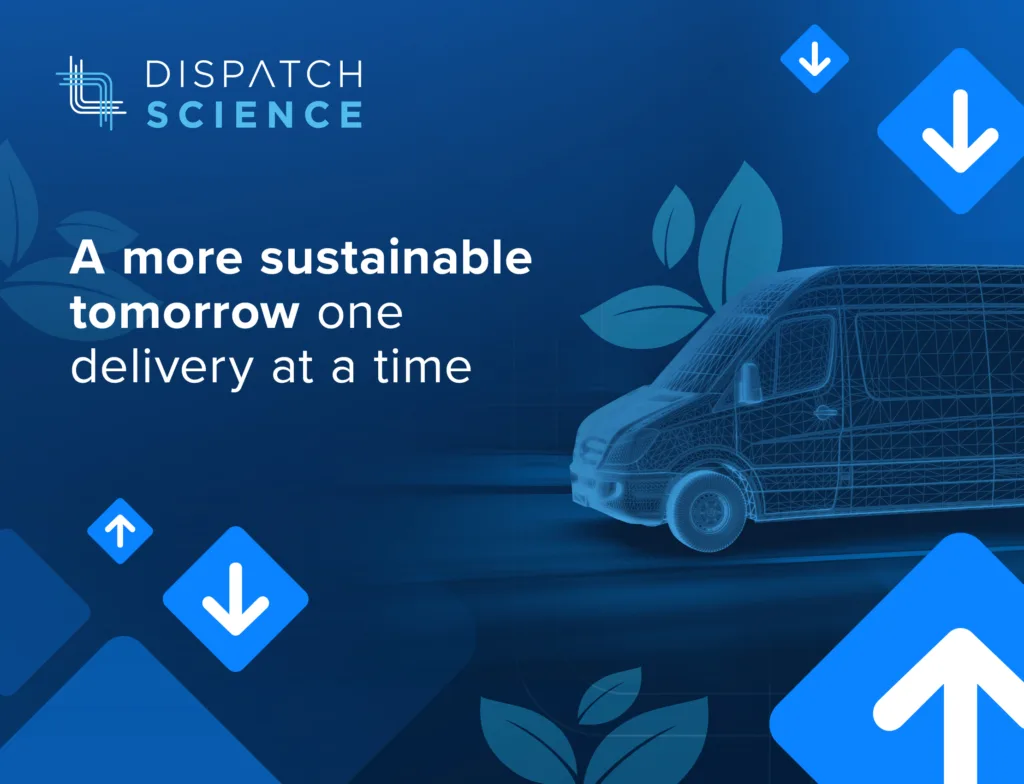Driving sustainability in the Last Mile – one delivery at a time.
The final stretch of the delivery process, known as the “last mile,” is critical in the logistics and supply chain industry. It directly impacts customer satisfaction and operational costs, but it also poses significant environmental challenges. As e-commerce and on-demand delivery services continue to grow, the last mile’s sustainability has become more important than ever. At Dispatch Science, we believe that every mile counts when it comes to protecting our planet. As a leader in last mile transportation management software, we are committed to delivering not just advanced technology, but also positive change. Here are some of the areas that we believe shippers and carriers should start thinking about when considering how to drive sustainability in the last mile.
1. Embrace Electric Vehicles (EVs) and Alternative Fuels
The use of electric vehicles (EVs) and alternative fuels in last-mile delivery can significantly reduce carbon emissions. Companies like Amazon and UPS are already investing in electric vans and trucks to replace their conventional fleets. This transition not only cuts down greenhouse gas emissions but also reduces noise pollution, making urban areas more livable.
Key Takeaway: Shifting to EVs, hybrid vehicles, and alternative fuels is a vital step towards reducing the carbon footprint of last-mile deliveries.
2. Optimize Delivery Routes and Load Efficiency
Route optimization technology and load efficiency strategies can dramatically improve the sustainability of last-mile logistics. By using advanced algorithms and real-time data, companies can minimize the distance traveled and maximize the number of deliveries per trip. By consolidating orders and delivering multiple packages in one trip, carriers can reduce the number of trips needed, further cutting down on emissions and traffic congestion. By curbing carbon emissions, curtailing fuel usage, and advocating for sustainable delivery options, delivery businesses and couriers can actively participate in preserving our planet’s well-being.
Key Takeaway: Using advanced route planning software and maximizing vehicle load are essential for reducing environmental impact and operational costs associated with the last-mile delivery process.
3. Implement Sustainable Packaging Solutions
Sustainable packaging is another crucial aspect of last-mile delivery. Reducing packaging waste, using recyclable materials, and optimizing packaging sizes can lower the environmental burden. Shippers and Carriers can also explore innovative solutions like biodegradable packaging and reusable containers to minimize waste.
Key Takeaway: Sustainable packaging reduces waste and enhances the overall eco-friendliness of last-mile deliveries.
4. Promote Local Fulfillment and Micro-Fulfillment Centers
Local fulfillment centers and micro-fulfillment hubs can drastically cut down the distance between the warehouse and the customer, leading to lower emissions. By strategically placing these centers in urban areas, companies can offer faster delivery times while reducing the environmental impact of their operations.
Key Takeaway: Local and micro-fulfillment centers help reduce travel distances and emissions, promoting a more sustainable last-mile delivery network.
5. Encourage Customer Participation in Sustainability Efforts
Educating and encouraging customers to participate in sustainability efforts can make a significant difference. Offering incentives for choosing eco-friendly delivery options, such as slower shipping speeds or consolidated deliveries, can help reduce the carbon footprint. Additionally, promoting awareness about the environmental impact of their choices can drive more sustainable consumer behavior.
Key Takeaway: Customer participation is key to achieving sustainability in last-mile delivery. Incentives and awareness can lead to more eco-conscious choices.
6. Carbon Offsetting
Through carbon offsetting initiatives, shippers and carriers can mitigate the ecological effects of their deliveries. By investing in projects geared towards reducing greenhouse gas emissions, such as tree planting or renewable energy endeavors, we collectively contribute to a greener, healthier world. The funds generated through carbon offsetting initiatives help drive innovation in the field of environmental science and sustainable technology. By investing in projects that push the boundaries of current capabilities, we can contribute to the development of fresh solutions for carbon reduction and climate change mitigation.
Key Takeaway: Carbon offsetting is a vital component of a comprehensive sustainability strategy in the logistics industry. By investing in carbon offsetting projects, it is possible to create a lasting positive impact on the environment.
Conclusion
Sustainability in the last mile is crucial for the future of logistics and the environment. By adopting electric vehicles, optimizing routes, implementing sustainable packaging, promoting local fulfillment centers, and engaging customers in sustainability efforts, we can make significant strides toward a greener and more efficient delivery ecosystem. Each of these key messages highlights a critical component in transforming last-mile logistics into a more sustainable practice, ensuring a healthier planet for future generations.
Together, let us create a path towards a more sustainable tomorrow, one delivery at a time.




